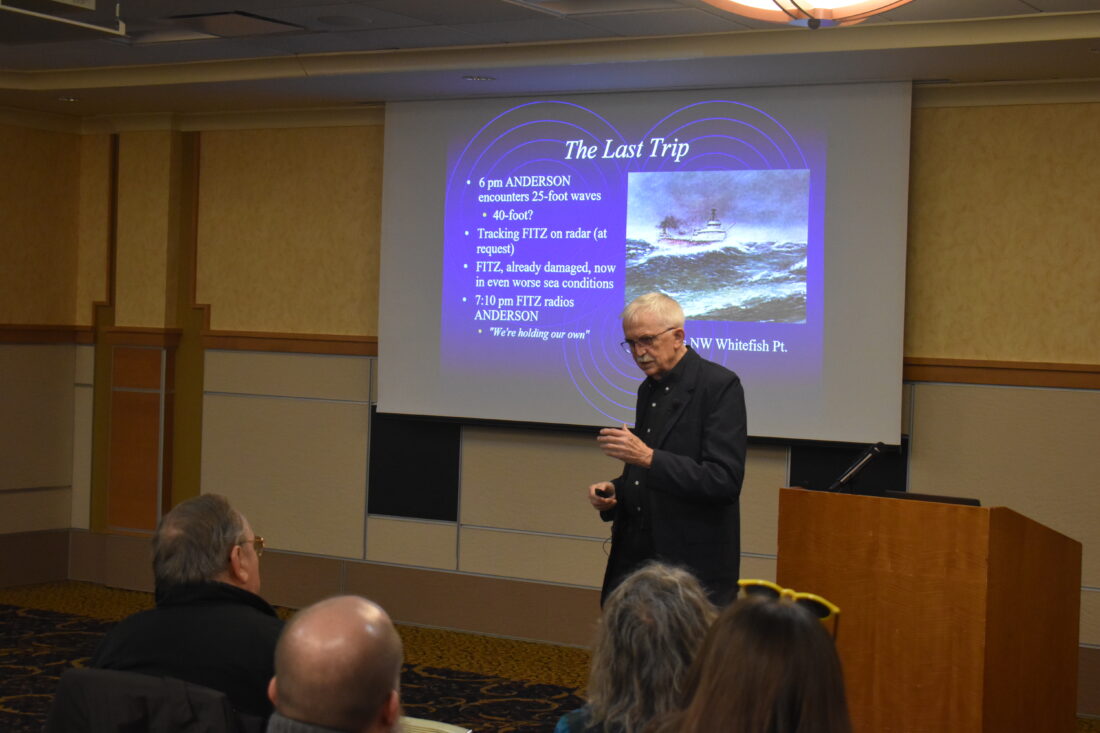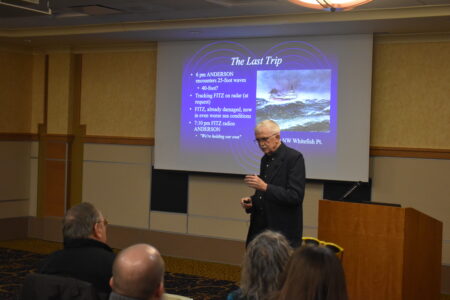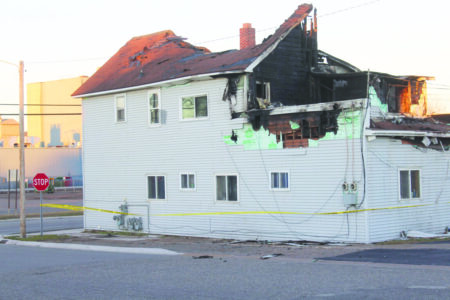When the skies of November turned gloomy
Presentation focuses on legendary sinking

Ben Garbacz/Daily Mining Gazette Frederick Stonehouse gave a presentation on the Edmund Fitzgerald following its 50th anniversary of the ship's sinking. Stonehouse is an author and historian known for his work regarding shipwrecks in the Great Lakes.
HOUGHTON — Maritime historian and author Frederick Stonehouse held a presentation on the Edmund Fitzgerald at Michigan Tech’s Memorial Union Building Saturday evening. The event was presented by the Van Pelt and Opie Library, Potage Lake District Library, The Library Network and Superiorland Library Cooperative in order to educate the public about the cargo ship which sank in Lake Superior 50 years ago last week.
Stonehouse has been a consultant with the National Park Service and Parks Canada and has 40 years of experience of shipwreck diving and searching in the Great Lakes. He wrote more than 30 books focusing on maritime history, primarily the Great Lakes. His book, “The Wreck of the Edmund Fitzgerald,” is a best seller which reviews the multiple theories regarding the sinking and how it might have been prevented.
Stonehouse is the recipient of numeous awards, including the 2006 Association for Great Lakes Maritime History Award for Historic Interpretation and the 2017 Great Lakes Shipwreck Preservation Society C. Patrick Labadie Special Acknowledgement Award.
Stonehouse said he draws from his personal involvement and research following the Fitzgerald’s sinking, and turns that into an hour-long presentation starting at the ship’s construction and ending with the impacts its sinking had on Great Lakes maritime safety regulations and procedures. His experience with the Fitzgerald was not only research, but personal interactions with people involved in the search and rescue as well as the captain of the Arthur Anderson, Jesse Cooper. The Anderson was another cargo ship which was tailing the Fitzgerald and was keeping an eye out for other nearby ships due to the Fitzgerald losing its radar. The Anderson was also the ship which had last contact with the Fitzgerald.
The weather on the day the Fitzgerald sunk started with gale warnings, and upgraded to storm warnings. It was Cooper’s account which led to the idea of 40 foot waves occurring in the storm. Cooper shared what he saw with Stonehouse at an event 10 years after the sinking, which was a wave crashing into the lifeboats on the Anderson.
“I know it was 40 feet, because at that point I’m 40 feet off the water. I know the size of this vessel,” Cooper told Stonehouse.
Stonehouse reviewed several theories which could have explained how the ship sank, and reviewed the multiple surveys and expeditions for the theories. In August 1989 the Michigan Sea Grant, National Geographic Fish and Wildlife, the Canadian government and The Great Lakes Shipwreck Museum in Whitefish Point did a survey of the wreckage with Stonehouse in the outfit.
The team used the best technology at the time to search for the “smoking gun” of the sinking. Even with the advanced technology, the findings were the same from investigations shortly following the sinking. The Coast Guard reports from July 1977 blames leaking from damaged and improperly and insecure hatches. The National Transportation Safety Board report in 1978 disagreed with the Coast Guard, citing cataclysmic collapse of one or more hatch covers, which would have sunk the Fitzgerald in minutes.
The aftermath of the Fitzgerald’s sinking led to updates in upkeep standards for Great Lakes vessels. Hatch covers and coamings were strengthened, due to the filling of the hatches being the prevailing theory leading to the Fitzgerald taking in too much water. Weather forecasting also improved, with the Great Lakes having over 50 buoys providing information to meteorologists and satellites in orbit providing its readings as well. Safety gear was also updated and encouraged which allowed people to withstand the temperatures of the Great Lakes.
“By remembering the Fitzgerald, we not only honor her, but also all the 6,500 shipwrecks on the Great Lakes,” Stonehouse said. “It also introduces a note of caution to operators and crews when sailing the Lakes. There are positive reasons to remember the Fitzgerald.”






